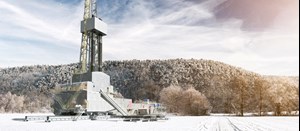Safety, efficiency and capability gain ground in receding market
Rig technology makes a hole, and gets you back out. That’s as true for the marketplace as it is for the lithology. Advances in rig technology helped fuel the success that dug the industry’s current hole; the next round of advances will help dig us out.
As they have in the past, those advances will likely center around several key themes. The safety of personnel, the environment and, ultimately, the asset, inspires a wide swath of risk-reducing innovation. Efficiency, always in demand, has become paramount, as a counterbalance to plunging oil prices. Today, the drilling process is subject to heightened scrutiny, aimed at squeezing expediency out of every step. And of course, there is capability; with the set of well challenges presenting an ever-moving target, rig advances must constantly match—and anticipate—the job that they will be asked to do.
The solutions include fit-for-purpose land rigs, automation and deepwater pressure control, as well as basic equipment components. In good times, new rigs, added to the industry’s onshore and offshore fleets, were a good indicator of technology entering the market. Watching what passed through the gate was a solid way to take stock of trends in specifications, hardware and processes. In contrast, rig cancellations are a poor indicator.
So this year, our focus is on the technology advances from the perspective of manufacturers and service companies, who are burning the midnight oil to advance rig technology in a tough marketplace. That examination reveals an industry that, while intensely focused on cutting costs, is also fully engaged in seeking and applying a broad scope of advances to improve safety, efficiency and capabilities.
DEEPWATER PRESSURE
New extremes and objectives sometimes demand a departure from the way that something has always been done. Take for instance, the venerable circulating system. Traditional systems, which are open to the atmosphere, are being challenged increasingly by the pressure and regulatory regimes of current prospects. This is especially true in deepwater drilling. Two related solutions, based on a closed-loop circulating system, are providing a way to manage pressure-related events in this environment: riser gas handling and managed pressure drilling (MPD).
Riser gas handling. Today’s deepwater prospects often demand an escalation in the methods used to handle increasingly complex drilling requirements. Traditional drilling methods often cannot respond adequately to urgent pressure-related well events, in time to avoid costly nonproductive time or much worse, says AFGlobal.
A good example is the presence of gas in the riser. Riser gas typically occurs when gas entrained in the mud system breaks out in the riser. Because it occurs above the control of the subsea BOP, it presents a unique risk to personnel, the rig and the environment.
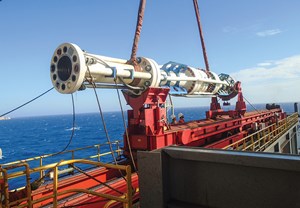
AFGlobal’s Riser Gas Handling (RGH) system is an innovative solution that implements a closed-loop circulating system on the rig. The component technology, which can be adapted to specific rig and operational requirements, manages riser gas aboard dynamically positioned and moored rigs. In doing so, it also provides the closed-loop context for implementing MPD, and advances the offshore market’s transition to MPD-ready rigs.
The system’s assemblies are integrated with the riser, using a suite of specialty joints and components. This assembly—when combined with SafeKick’s SafeVision automation software—forms the company’s Riser Gas Management (RGM) system, Fig. 1. The riser assembly is deployed with integral choke, kill, boost and hydraulic lines, which makes it immediately available to support drilling operations. Its component design facilitates integration of third-party MPD equipment, and a multi-purpose control umbilical can be used with both RGM and MPD-RCD applications, making the rig MPD-ready.
The RGM system provides a means of safely and effectively handling formation gas in the riser, by diverting wellbore flow away from the rig floor and enabling a controlled process for removing gas from the riser. The system allows large volumes of gas to be handled safely, for longer periods of time, to greatly reduce the risk of riser unloading. The system also provides semi-autonomous control of drilling returns to predefined rig systems.
Circulating gas out of the riser depends on purpose-built equipment coupled with real-time monitoring and control, says AFGlobal. Its system uses automation software to support better-informed decisions at the well site, while real-time monitoring and control help the driller avoid incidents that can lead to catastrophic events. Clear visualization of downhole conditions helps identify, manage and avoid unplanned events. The system is designed to provide a dynamic response to wellbore changes that enhances human decision-making, enabling risks associated with wellbore and riser pressures to be managed more effectively.
Managed pressure drilling. As oil and gas operations expand further into deepwater frontiers, the industry is discovering the limits of even the most advanced conventional drilling techniques. Deepwater operators must find new methods to safely navigate through narrow pore-pressure windows and frequent kick-loss scenarios that characterize this high-profile arena, says Weatherford International. MPD—the closed-loop drilling process that enables precise control of the wellbore’s annular pressure profile—has become the new “conventional method” for drilling in the deepwater sector.
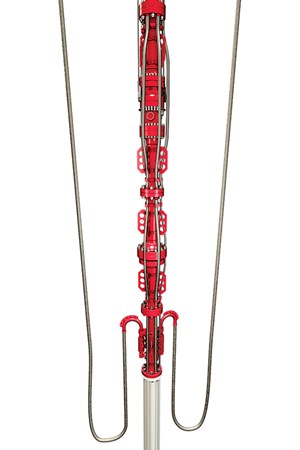
MPD systems are being retrofitted increasingly onto existing rigs, or designed into newbuilds in preparation for drilling hard-to-reach assets. To effectively mitigate the hazards posed by drilling in Brazil’s challenging pre-salt formation, for example, many new rigs are now required to incorporate MPD technologies before drilling exploratory and appraisal wells.
Weatherford distinguishes an MPD-ready rig, based on several key technology components, including an MPD control system and a deepwater MPD riser joint, inclusive of a below-tension-ring (BTR) rotating control device (RCD) to contain annular fluids while drilling, Fig. 2. The process of retrofitting the rig typically involves rerouting auxiliary lines and overcoming space restrictions, to incorporate the surface piping, cabling and instrumentation required to link MPD components with existing rig equipment. Retrofitted rigs’ operating procedures must also adhere to MPD hardware and software protocols.
The company’s approach to rig modification centers on its automated Microflux MPD control system, which detects and automatically manages minute kicks or fluid losses to prevent potentially dangerous well-control scenarios. By maintaining constant bottomhole pressure (BHP) and achieving a continued and precise balance between the pore pressure and fracture gradient, the Microflux system mitigates potential kick/loss cycles. The system also can monitor wellbore parameters, such as pore and fracture pressure gradients, equivalent circulating density (ECD), and surge/swab pressure while drilling and making connections. The MPD control system’s automatic choke manifold augments its ability to immediately adjust surface backpressure in response to any downhole event.
Working in concert with the MPD control system is a BTR RCD. The RCD’s bearing assembly transforms the rig’s open fluid-return system into a closed-loop system, enabling MPD. This setup also introduces a secondary barrier in the riser to prevent gas influxes and kicks, which, in open-to-atmosphere systems, can occur as gas breaks out of solution above the subsea BOP. Moreover, the design of today’s MPD systems has made integration relatively seamless; the RCD and MPD riser joint are incorporated in a way that does not interfere with existing auxiliary lines, such as riser, choke and kill lines.
Having met the rig’s regulatory requirements, these MPD technology components comprise a system that enables dynamic well control. MPD equips operators with the technology needed to detect, confirm and manage minute fluid influxes and losses with a degree of precision unattainable using conventional methods, giving them added real-time control and, in many cases, eliminating the need for a secondary well-control measure altogether.
By dramatically cutting time associated with identifying, responding to and controlling an influx, MPD minimizes the overall pressure to which the wellbore would have normally been exposed, preventing irreparable damage that is largely unfavorable, especially in today’s economic environment.
EFFICIENCY AND SAFETY
Optimization and automation of drilling processes has long been the path to achieving drilling rig efficiency and safety. The two work hand-in-hand, to reduce risk to personnel poised by rig floor operations, and to streamline the drilling process with precise, repeatable operations. These rig advances, described in hardware, software and data, are at the center of modern rig capabilities. They are the keystones that support continued advances in how wellbores are drilled, and how drilling programs are planned.
National Oilwell Varco (NOV) has developed a service that enhances the ability of crews and engineers to improve rig performance, enable real-time decision-making and enhance analytical capabilities.
The eVolve Optimization Service, developed by NOV Wellbore Technologies, is based on continuous improvement that begins with a critical review of key performance indicators and drilling data. Using a suite of optimization software, NOV experts then build an optimization strategy that includes a drilling plan, BHA design assistance and the creation of drilling parameter roadmaps. The multi-tiered service provides for customized levels of support.
NOV cites a project in the Bakken shale, using the premium AUTOMATE tier of the eVolve service. The project began when oil prices and the rig count started to decline in December 2014. The initial focus was to show performance improvements on one rig, but that emphasis soon shifted to the generation of lessons-learned that could improve the entire fleet. The goal had to be accomplished while maintaining a performance level that guaranteed the project would reach break-even.
The project followed a plan-do-check-adjust cycle, for creating lessons-learned and targeting key performance limiters. By providing the user with high-density data, the service allowed for a shortened decision-making cycle and improved clarity of downhole drilling dynamics in real time.
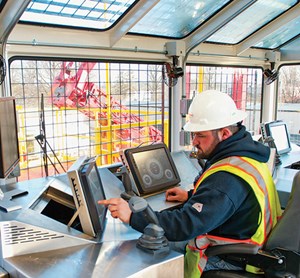
The Bakken project involved more than 16 wells and drilled more than 143,000 ft of hole. NOV reports that its eVolve service was instrumental in a 30% reduction in drilling time, while generating a range of lessons learned, such as BHA configurations, connection practices and vibrational mitigation that could be applied to the remaining rig fleet.
FIT-FOR-PURPOSE DRILLING
With oil prices at record lows, today’s shale drilling industry is often centered on cost containment through efficiencies. One way that efficiency is being sought is through customized drilling that very specifically matches the rig to the task.
Schramm, Inc., says that because the shale industry now understands the rock better than ever, operators are looking to strategically customize drilling programs, specific to the asset being developed. This tailored approach, also known as fit-for-purpose drilling, allows operators to squeeze every bit of value out of their operations, optimize efficiencies and lower the cost of extraction.
Important to the success of this customization strategy is using the right-sized tool for the right cost, says Schramm. During the height of the shale revolution, there was a lot of pressure on companies to drive down drilling cycle times. Some manufacturers responded by equipping rigs with more horsepower, and the result was that reservoirs were damaged, because they were drilled too quickly. At the end of the day, the value of an oil field is in the estimated ultimate recovery (EUR) of each well. Drilling too fast, and junking reservoirs, can cripple the value of a company’s acreage position, observes Schramm.
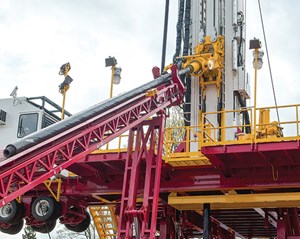
The company’s advanced rigs emphasize power density over horsepower, an approach that allows drillers to maintain wellbore tolerance in the production zone and ensure that the well maximizes EUR potential. These rigs also have a smaller footprint, are easier to transport, and are able to walk and rotate 360°, giving them more efficient movement from pad-to-pad and well-to-well. As the industry shifts to a more efficient value-focused understanding, there is growing recognition that drilling within the cycle-time sweet spot helps secure the value of the well. As a result, many operators are demanding agile rigs that enable wells to be drilled in the same overall time.
The relationship between operators and rig manufacturers also has changed in this new landscape, says Schramm. When oil was $120/bbl, operators were willing to use the biggest, fastest rig available, although it had a higher day rate and might not have been the best rig suited to the demands of a particular basin. Schramm says that operators are now frustrated by this “one-size-fits-all” approach to drilling rigs. Increasingly, they want to collaborate with rig manufacturers and contractors to strategically choose the right rigs and equipment for the job, with the goal of ensuring economically sustainable operations that optimize efficiencies and cut costs.
The concept of customization hinges on the idea of consultation. Increasingly, operators are working closer with rig manufacturers and contractors to design tailored drilling solutions. Operators know the rock, and contractors know how to maximize their technology options to best achieve the end game—a customized drilling solution that optimizes the well’s ultimate productivity. Today, operators have more options—from 100% hands-free pipe handling to off-the-shelf rigs that tap electrical high line power to drill horizontal wells all the way to TD, Figs. 3 and 4.
In this era of efficiency optimization, or Shale 2.0, says Schramm, companies that embrace collaboration, diversity and customization will be best-positioned to weather the storm and come out of it with a long-term, durable competitive advantage.
ARCTIC CUSTOMIZATION
National Oilwell Varco’s Train Rig tackles safety, efficiency and capability with a rail-mounted solution for pad drilling in extreme Arctic conditions. Developed in Russia, and designed to meet API and Russian requirements, the 320-metric-ton rig is an AC rig powered off high lines. Part of NOV’s Custom Terrain Series of rigs, it operates in a –40°C to +40°C environment. The rig moves from well to well along a 350-m rail, without rigging down, using a rollers-on-rail hydraulic cylinder system. Winterization protects the crew, while a modular design and an innovative cable management system enhance moves. The rig’s mast and substructure design allow quick, easy rig up at ground level. Equipment includes advanced Amphion drilling controls, a 37,500-ft/lb TDS top drive, and an Iron Roughneck rated to 60,000 ft/lb, make-up, and 80,000 ft/lb, breakout torque.
TOOLS FOR SAFETY
Not all efficiencies involve a big solution or major change. In a business climate focused on low cost, basic improvements that result in simple, safe handling and lifting solutions continue to play a significant role, as they build on synergies between safety and efficiency.
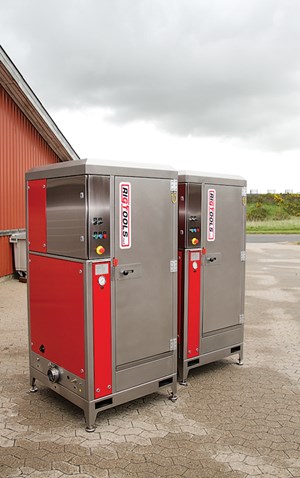
Adding value, cutting costs, improving efficiency, solving HSE issues, etc. are particularly relevant in the current market, says RIGTOOLS. The company observes that tested, certified tools designed to prevent people from pinching hands and toes help reduce and eliminate the considerable costs of even minor accidents. These tools, in concert with standardized procedures; consistency in lifting and handling procedures; and other basics; are important elements of a long-term approach to improving safety and efficiency.
Their BHA Wash Tool is a system of high-pressure nozzles mounted on top of the diverter or bell nipple to clean the assembly without exposing personnel to “red zone” rig floor operations.
A clamp tool for lifting subs is designed for safety and certified handling, Fig. 5. Another innovation is an automatic shaker screen washer. The Monsoon, says RIGTOOLS, can extend screen life by 25% or more by cleaning dirt off the variously sized screens, without exposing personnel, or the environment, to mud and chemicals. Vapors are handled through an exhaust pipe, Fig. 6. ![]()
- Coiled tubing drilling’s role in the energy transition (March 2024)
- Digital tool kit enhances real-time decision-making to improve drilling efficiency and performance (February 2024)
- E&P outside the U.S. maintains a disciplined pace (February 2024)
- U.S. operators reduce activity as crude prices plunge (February 2024)
- Drilling advances (January 2024)
- Driving MPD adoption with performance-enhancing technologies (January 2024)

